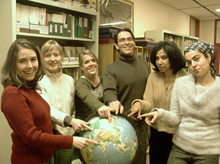Geography students critique Indian dam project

Carla Pesce, Jennifer Taylor, Natacha Labonté, Keshav Letourneau, Eleonora Cayer, Laila Malik. Missing from photo, Joe Ronzio.
Photo by Marc Losier
A group of graduate students in Environmental Impact Assessment (EIA) have a chance to put their work and their program of study on the map.
Last November, Patrick McCully, director of the International Rivers Network (IRN), based at UC Berkeley (California), gave a talk at Concordia about the adverse social and environmental effects of large dams. After his speech, Professor Monica Mulrennan, director of the EIA diploma program, and Professor Kathy Roulet, an instructor, were approached by the NGO to see if graduate students were interested in taking on one of IRN’s missions.
All students in the program were given the opportunity to participate in the project as part of a required course or an equivalent three-credit research paper. A group of seven students jumped at the offer, and are now working hard to complete a 200-page report before their April 6 deadline.
“The task is to critique an environmental assessment of a large-scale dam, entitled the Siang Middle Project, proposed for the northeast of India, in the state of Arunachal Pradesh, a state mostly comprised of tribal peoples who practice subsistence cultivation,” said Jennifer Taylor, one of the students.
“The best-case scenario would be for our report to reach decision-makers and convince them that the plan is incomplete and incapable of mitigating the many negative effects this project will have, both socially and environmentally.”
Environmental assessment is a way to predict what impact a development project is going to have on the environment, including humans.
“I think everyone would agree that this is an incredible opportunity,” said Joe Ronzio, another member of the group. “The fact that this is a ‘real world’ project and that the lives of many people and the environment depend on it, definitely increases our motivation to perform a quality analysis, and inspires us to go beyond the typical student effort to ensure the job is well done.”
There are many aspects to the critique of this assessment, each of which is covered by a different student. These include aquatic ecology and fisheries, an environmental management plan, a catchments’ treatment area plan, as well as provision for resettling and rehabilitation.
Taylor explained, “India has a fairly notorious history of poor planning when it comes to dam projects, with estimates of the number of people displaced by them ranging from 20 to 50 million in the last 50 years or so.
“This project, judging by the assessment, is also lacking in pretty much every aspect, including adequate baseline studies, proper disaster management strategies, fair compensation, and adherence to international law regarding indigenous peoples.”
Established in 2000, the graduate diploma program in EIA offers students a one-year multidisciplinary curriculum in a field that is lacking qualified personnel. This program, designed for recent graduates as well as working professionals, is offered by the Department of Geography, Planning and Environment.
According to Mulrennan, “A major emphasis of our program is to expose students to the real-world application of environmental impact assessment.” She added that most of the research conducted by students during their studies tends to focus on local projects because of the familiar policy context as well as accessibility of documents and information.
“Access to information concerning EIA in less developed countries is usually extremely problematic, which is why the opportunity presented by the IRN project was so unusual.
Because the students were invited by the IRN to contribute to the review and analyze the EIA report, it has meant that they have had access to individuals and local NGOs who are intimately familiar with the project.”
She also said that based on the experience of this project, “learning first hand about the nature and extent of the impacts of large-scale dam projects, particularly with respect to environmental degradation, has proven to be a much more powerful learning tool than the conventional textbook or lecture on this topic.”